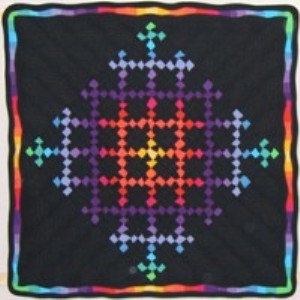If you read my previous post, you'll now know all about Temperature Quilts.
Want to sew along with me in 2023? Then read on for some tips and useful bits of information!
Choose your fabrics
The first step is to decide which fabrics you want to use for your quilt. Basics/blenders work the best for a number of reasons. Most importantly, they are usually readily available so choosing a basic collection like a solid or Moda Grunge means that if you run short of a particular fabric, you should be able to buy more. Your quilt is going to be a riot of colour (or tone if you are using neutrals) so you want all your fabrics to work together. Some quilters also like to add an extra fabric to their blocks for noting if it has rained, snowed or been sunny.
How many fabrics do I need?
When I made my first quilt in 2019, I decided to use twenty different fabrics with each fabric representing 2deg centigrade. However, that year the UK hit new highest temperatures and I needed to extend my hot colours by a couple of fabrics so I could reach that new high. Had I made a Temperature Quilt the year before, in 2018, I would have needed a couple of lower temperatures as where I lived was hit by The Beast of the East that winter with some very low temperatures.
I now reckon on using twenty four fabrics and allow for temperatures to range from between -9deg C and 38deg C. In my 2022 quilt I will have used every fabric in my selection!
How much should I buy?
To some extent, this depends on the block you are using. Most people recommend buying 50cm of each fabric. In all probability, you aren't going to need that much for the absolute lowest and highest fabrics in your selection but you might need a little bit more of those low teen temperatures which can be highs in the spring and autumn months, but can also be lows during the summer months. The Grunge bundle I have curated has taken this into account. You can buy one in the store here.
How do I find my temperatures?
I like to use the Met Office website for my temperatures. This is the link to my nearest weather station. Click on it and change the location to your town to get yours. Another good site is Time and Date which allows you to search for current weather temperatures as well as ones you might have missed. If you're looking for an app, Wunderground is quite useful. The main thing is to remember to note down your high and low temperatures each day; as long as you have those it doesn't matter if you fall behind with making your blocks as you still have the data you need to make them. I note my temperatures down in my desk diary.
Which block shall I use?
Whichever block you decide to use, it needs to be a simple one that can be made easily with just two fabrics. Flying Geese blocks are great, as are simple Half Square Triangle blocks or a Nine Patch block like I'm using for my 2022 quilt. This was 1 January 2022, a very mild start to the year!

If applique is your thing, then circles work well as does the Orange Peel block I used for my 2019 quilt.

Have a look online or on Instagram searching for 'Temperature Quilt' for more inspiration, not only for blocks but also colour stories; there are some really interesting quilts made with neutrals too.
What next?
Download my swatch sheet for recording your fabrics and temperatures. This is my sheet for 2022.
You can see I've allowed from -9deg C to 38deg C. Take a look online for a guide to the usual high and low temperatures where you live (you'll have a rough idea anyway). There's no right or wrong scale. I allow 2deg C for each fabric. If you want to use less fabrics, allow perhaps 3deg C or more for each fabric. Be prepared to need to add a fabric or two at the top or bottom ends of your selection. Had where I live reached 40deg C this summer (like several places in the UK did), I had the potential to add a paler pink or white to the top end of my scale.
Now to get ready to start keeping a note of temperatures from 1 January 2023!

